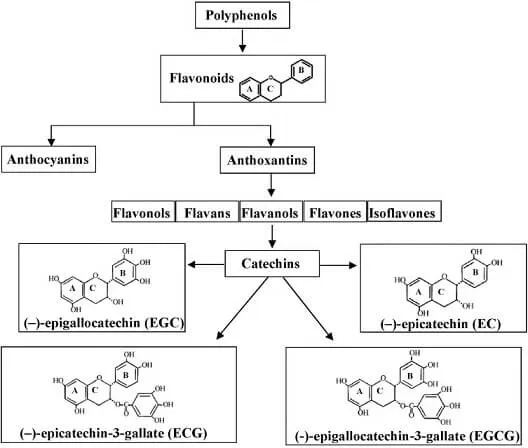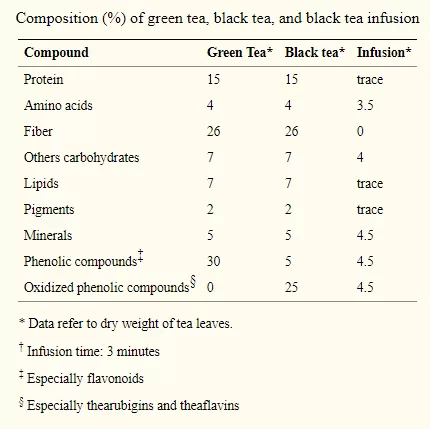Green tea has higher amounts of polyphenols in it when compared to black tea because it does not undergo too much processing.
People all over the world drink green tea because of the amazing health benefits it has to offer. Like other tea varieties, the leaves of the Camellia sinensis plant are the source of green tea.
However, the fact that the processing is done differently sets this tea apart from the rest.
What are Polyphenols?
Basically, polyphenols work as reducing agents. When they are clubbed with antioxidants like vitamin C, vitamin E, and carotenoids, they help protect the tissues of the body from oxidative stress.
This helps in preventing associated diseases such as cancer, heart disease, and inflammation. There are four major components namely, epigallocatechin gallate (EGCG), epigallocatechin, epicatechin gallate, and epicatechin.
In addition, there are flavonols such as kaempferol, quercetin, and myricetin in it as well. They have anti-inflammatory and anti-carcinogenic effects to offer.
Talking about the types of polyphenols, there are essentially 3 types of them, namely:
- flavonoids,
- stilbenes, and
- lignans.
Their phenol rings and binding properties distinguish them. These rings have phenyl and hydroxyl group structures and it is because of them that polyphenols have anti-inflammatory and antioxidant properties.

Every polyphenol class is further classified based on the interactions of phenyl rings with oxygen, carbon, and organic acid molecules.
One can categorize flavonoids are into 2 main classes – anthocyanins and anthoxantins. There are further 6 subclasses called flavonols, flavans, flavanols, flavones, and isoflavones.
The most active catechin in green tea is EGCG (epigallocatechin gallate) which is a powerful antioxidant.
The Problem with polyphenols
When administered orally, polyphenols don’t get absorbed properly by the body. Being highly soluble, they can’t seep into membranes and become unstable in the gut due to their nature of being reactive.
Even the bacteria in the gut tend to degrade the polyphenols.
Moreover, consuming green tea in large doses can be detrimental to health. It contains caffeine which should not be a problem when consumed within limits.
However, once you overdo it, it can lead to stomach related problems, nausea, feelings of restlessness, anxiousness, and insomnia. Those who are sensitive to caffeine should also cut back on their consumption of green tea.
Apart from caffeine, there are other polyphenol compounds that can have side effects and one among them is flavonoids. They hamper the absorption of iron by the body and can lead to iron deficiency. So, avoid drinking green tea with your meal.
Additionally, pregnant women have to be careful when they drink green tea. It contains tannins that prevent the absorption of folic acid. Going above 3 cups can have a negative impact on the growth of the unborn baby.
Polyphenols and their Antioxidant Properties
As already mentioned above, polyphenols have antioxidant properties. Antioxidants actually are molecules that neutralize the free radicals in the body. Free radicals when not countered can cause severe damage to the body cells leading to several chronic health conditions.
Antioxidants save your body from that possible damage.
However, there are certain polyphenols that are considered to be antinutrients. Just like their name suggests, these compounds hamper the body’s ability to absorb certain essential nutrients like iron.
It is better to avoid drinking green tea with meals.
Apart from green tea, coffee, vegetables, fruits, and berries are also a great source of polyphenols. While a cup of tea or coffee has 100 mg of polyphenols, a 100 g of certain fruits have 200–300 mg polyphenols in them. But does cooking affect them?
Well, instead of frying, steam-cooking veggies helps in retaining the phenolic compounds present in them.
Therefore, you must add a lot of plant-based foods to your diet and cook them the right way to make the most of their goodness.
Polyphenols in Green Tea
Green tea is rich in polyphenols. The polyphenols in green tea include catechins, gallic acid, theaflavins, tannins, and flavonoids. In addition, it includes epigallocatechin gallate (EGCG), epigallocatechin, epicatechin gallate, and epicatechin.
These work as antioxidants and offer a number of health benefits. They lower inflammation in the body and prevent early signs of aging, cancer, diabetes, arthritis, heart disease, and neurodegenerative diseases.
By weight, the polyphenol content in green tea is 20-45% and out of that 60-80% are catechins.
Therefore, it is important to make green tea a part of your daily diet as the polyphenol-rich beverage is anti-inflammatory, anti-cancer, and cholesterol-lowering.

There are flavonols such as kaempferol, quercetin, and myricetin too. EGCG (epigallocatechin-3-gallate) in polyphenols is the main compound responsible for the medicinal properties of green tea.

Here is a closer look at how the antioxidant effect of polyphenols in green tea benefit those who consume it regularly.
Benefits of Green Tea Polyphenols
Improves heart health
The flavonoids in green tea protect the heart by preventing the formation of blood clots and help in enhancing the function of blood vessels. Moreover, green tea keeps cholesterol levels in check.
Studies say that those who drink up to 3 cups of green tea a day have a 43% lower risk of suffering from a heart attack and have a 70% less chance of death due to one.
Prevents cancer
Drinking green tea is known to reduce the risk of cancer. Studies reveal that it prevents certain types of cancers. According to researchers, cancerous cells stop growing due to green tea’s polyphenol content.
While the studies are not yet conclusive, there is no harm in drinking green tea for overall well-being.
Controls type 2 diabetes
Type 2 diabetes is a condition in which the cells of the body are not able to utilize blood glucose because of insulin resistance. The health-enhancing catechins in green tea help in reducing insulin resistance and therefore help people with diabetes.
Green tea may not be able to control diabetes all alone. However, it is always a great addition to a balanced diet meant for diabetics.
Helps in weight loss
EGCG, the active catechin in green tea is a common component in most weight loss supplements and fat burners. This is because studies show that the catechin helps in aiding weight loss.
While this might be true, green tea won’t work magically to knock off the extra pounds. It has to be clubbed with healthy meals and an active lifestyle.
Whatever it may be, swapping your sugary drinks with a cup of calorie-free green tea is a step towards good health.
Helps fight signs of aging
Green tea may not be the elixir of youth but it has skin-protective properties. This is again due to the antioxidant properties of catechins present in the tea. The topical application of green tea polyphenols can even slow down certain signs of aging.
Why do you extract polyphenols from green tea?
Green tea polyphenols provide many medicinal benefits. As you already know, green tea has a number of compounds that are beneficial for overall health and well-being. And, extracting these in concentrated form increases the nutritional value of the food.
There are certain methods to extract polyphenols from green tea and they are:
- Conventional solvent extraction
- Ultrasound-assisted extraction (UAE)
- Microwave-assisted extraction (MAE)
- High hydrostatic pressure (HHPE)
- Supercritical fluid extraction (SFE)
Do all teas have polyphenols?
Tea has nearly 8-10x times the amount of polyphenols present in fruits and vegetables. All the tea varieties from the Camellia Sinensis plant or simply the ‘tea plant’ have polyphenols in them.
No matter whether the tea is black, green, white, or oolong, it is rich in polyphenols.
The Final Takeaway
The presence of polyphenols in green tea has an important role to play in promoting one’s health and overall well-being. Right from fighting signs of aging to preventing cancer, the antioxidant properties of its active plant compounds have a lot to offer.
Source:
https://pubmed.ncbi.nlm.nih.gov/12109813/
https://www.ncbi.nlm.nih.gov/pmc/articles/PMC3124776/
https://www.ncbi.nlm.nih.gov/pmc/articles/PMC2855614/
https://www.hindawi.com/journals/omcl/2012/560682/
https://link.springer.com/article/10.1007/s11947-015-1479-y
